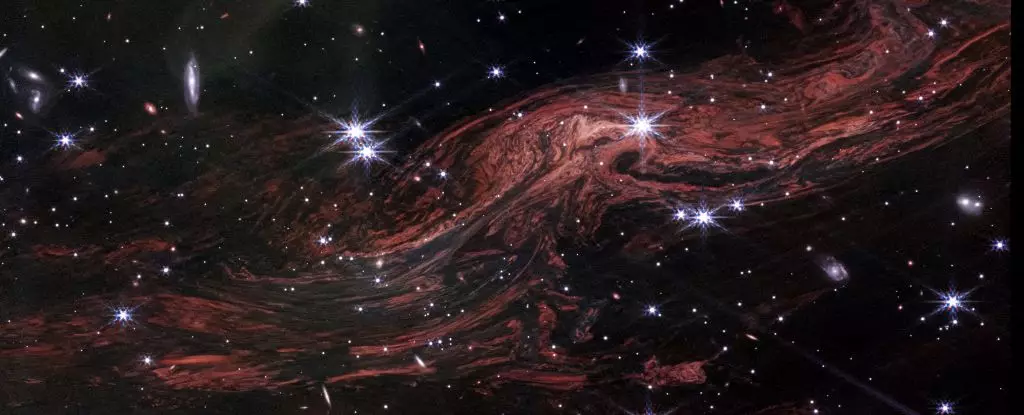The cosmos has always fascinated humanity with its vastness and mysteries. Recent advancements in astronomical technology are peeling back layers of this enigma, allowing us to observe the universe with unprecedented clarity. A prime example of this shift comes courtesy of the James Webb Space Telescope (JWST). With its capacity for infrared observations, JWST is uncovering the intricate structures of the interstellar medium—the nearly invisible substance that fills the void between stars—with remarkable precision. This exploration is illuminating not just the remnants of a historical supernova, known as Cassiopeia A, but also revealing the delicate, complex nature of cosmic dust.
Cassiopeia A, a supernova remnant that exploded roughly 350 years ago, has long been a focal point for astrophysical study. This celestial event, witnessed in 1670 from approximately 11,000 light-years away, has been crucial in understanding stellar death and its consequential effects on surrounding space. Until now, observations of the dusty regions surrounding this remnant were largely limited. The JWST’s ability to detect and analyze the faint red light emanating from this cosmic terrain has opened a new chapter in our understanding. For the first time, astronomers can observe how the light from Cassiopeia A interacts with the dust—illuminating a whole world of structures previously obscured to us.
One of the most remarkable phenomena revealed through JWST’s observations is the “light echo.” This occurs when the light from a brilliant explosion in space interacts with dust clouds, creating a cascade of reflections—similar to an echo of sound waves against a wall. This interplay not only provides a time-lapse effect of the explosion but also maps the density and composition of space’s soft underbelly. In practical terms, these echoes serve as a way to visualize the invisible, helping researchers piece together the spatial arrangement and characteristics of cosmic materials. Unlike before, when only brighter supernovae yielded notable echoes, the JWST’s advanced infrared vision permits the identification of thinner dust clouds situated farther from light sources, enhancing our comprehension of cosmic landscapes.
The observations from JWST have unveiled the interstellar medium as a complex network of layers—much like the rings of an onion. Astronomers have noted that this medium comprises densely packed sheets interspersed with whorls and knots, reminiscent of intricate tree bark patterns. This structured arrangement offers clues to the behavior and evolution of cosmic dust. Notably, the imaging technology resolves details on a scale of approximately 400 astronomical units, a substantial accomplishment that allows for refined modeling of the material’s behavior and properties.
This newfound clarity beckons deeper inquiries into the basic mechanics of the interstellar medium, including its potential relationship to magnetic field lines traversing through space. This connection may provide insights into gravitational interactions and the processes at play during star formation and evolution, ultimately enhancing our understanding of cosmic structures.
The implications of these findings might be likened to the introduction of computed tomography (CT) scans in the medical field. Just as CT scans reveal complex internal structures in human anatomy, JWST’s ability to capture time-sensitive images allows astronomers to study the interstellar medium in ways that were previously thought impossible. Information gathered from serial observations at different times effectively creates a three-dimensional model of the interstellar environment, significantly enhancing our approach to studying cosmic phenomena.
As detailed studies of the interstellar medium continue, more presentations and discussions will undoubtedly follow, further refining our understanding of these intricate cosmic structures. The ongoing work by astrophysicists like Jacob Jencson and Josh Peek exemplifies the collaborative efforts emerging from JWST’s revolutionary capabilities. This new era of astronomy, marked by deep-space insights and revelations, promises to transform our understanding of the universe, its components, and the intertwining narratives of stars and blind galactic dust.
JWST’s observations not only enhance our understanding of historical events like Cassiopeia A’s supernova but also instill a deeper appreciation for the complexity of the interstellar medium. This exploration challenges our perception of cosmic dust and uncovers the nuanced interactions that define our universe, paving the way for future astronomical discoveries that will continue to astonish and inspire.

Leave a Reply